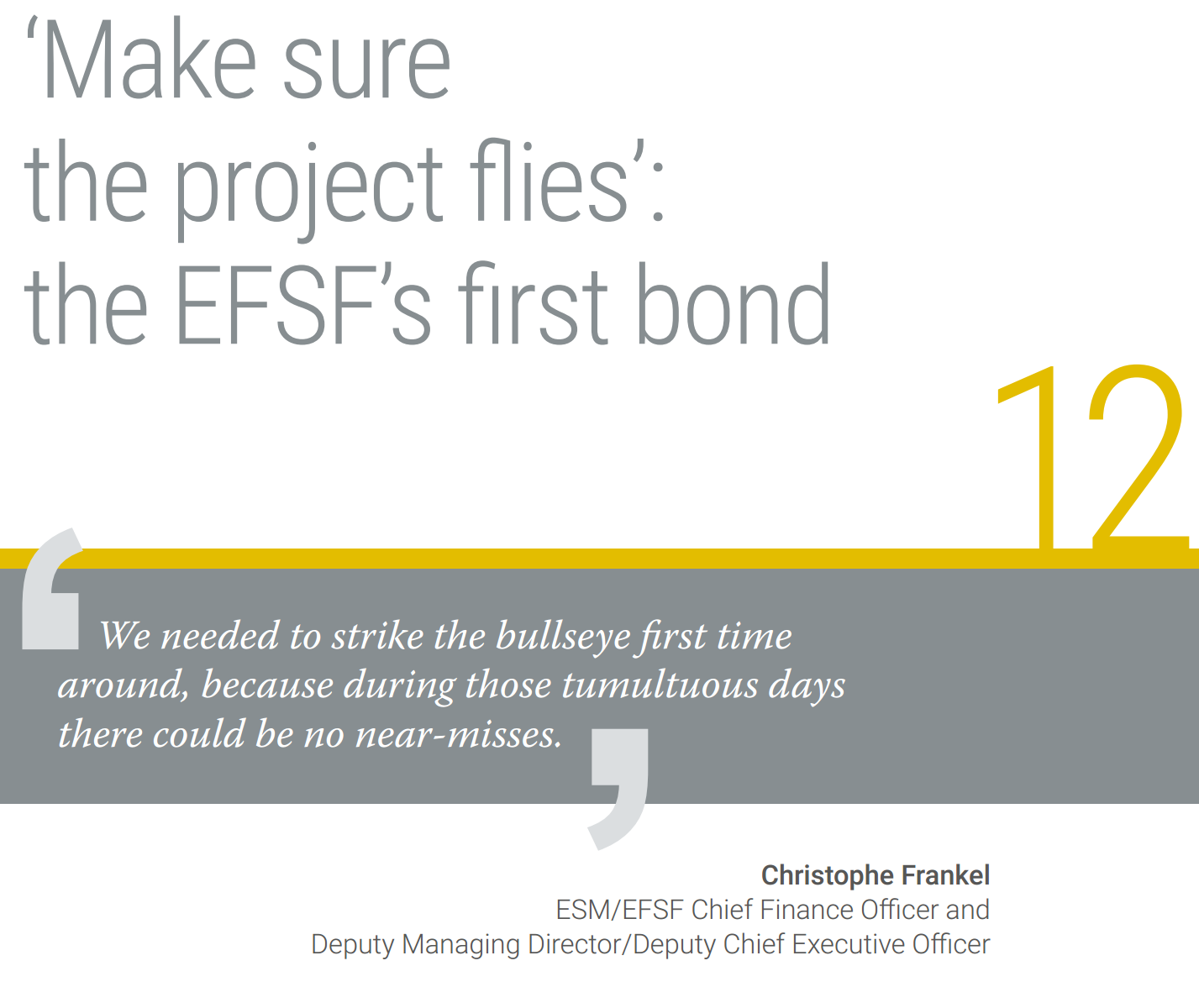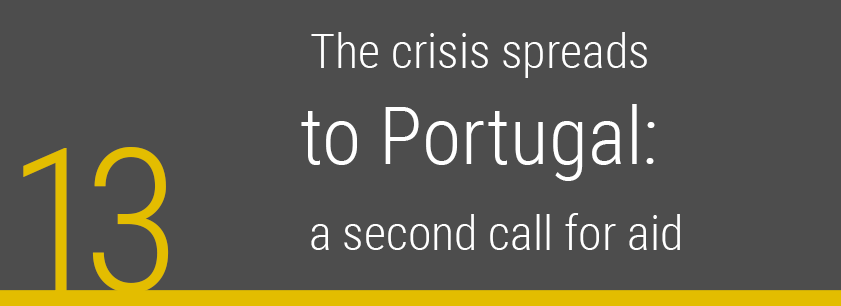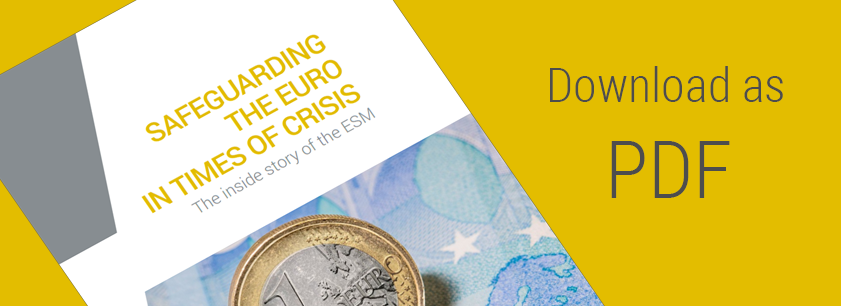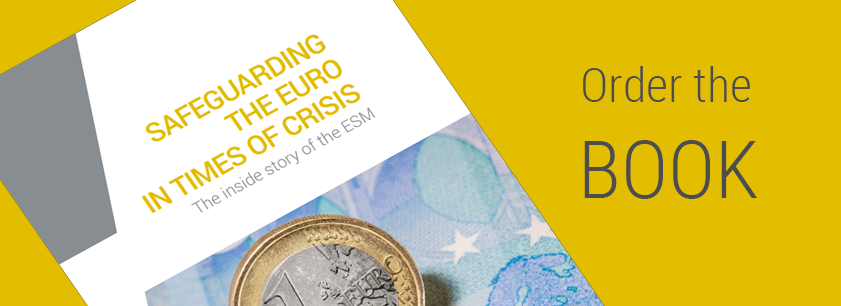
Once the EFSF secured a provisional AAA rating from all three big-name rating firms, it was primed to go to the markets if needed.
In the months before Ireland’s formal request, the EFSF team prepared for what could be coming, lining up investors and clearing a number of obstacles. But, when Ireland did apply for rescue loans in November 2010, with cash needed quickly, the firewall had to pick up the pace to get its first-ever programme ready to go.
‘The first “surprise” was when we went from being a firewall that would never be tapped to one that was actually going to be tapped,’ said Chief Economist Strauch. ‘That piled on the pressure. We shifted from the orderly mode of getting the rating, arranging the mechanics, up into a higher gear with a clear and urgent deadline.’
Frankel, CFO of the EFSF and head of the roadshow team for the inaugural sale, agreed. ‘The rush came when Ireland formally asked for assistance at what seemed to us very late in the process.’
Starting with a fresh slate brought new challenges. For one thing, the euro fund didn’t have instant name recognition. Bond markets were also getting used to the EU’s emergency fund, the European Financial Stabilisation Mechanism, or EFSM, set up the same weekend as the EFSF and also designed to help members with market access problems. And there had been a French entity called the Societé de Financement de l’Economie Française, or SFEF, now defunct. But the EFSF stood for something new and different.
‘The names didn’t help. But at the same time, it was good that we had to explain things to investors,’ Frankel said. ‘It was a way for us to make sure that everyone really understood the new organisation and how it worked.’
On the plus side, the new entity had some weighty backers. These included all euro area member states, which were its shareholders, and the German sovereign’s funding arm, the German Finance Agency, which had agreed to process its market operations. The German agency’s imprimatur offered immediate institutional credibility, along with the secondment of its senior funding expert, Thomas Weinberg. By outsourcing its funding operations, the EFSF ensured they would be in experienced hands. Weinberg, well known and trusted in the markets, would run the borrowing team in its initial stages.
It was a critical moment. As an issuer that stood for the entire euro area, if the EFSF could not raise the funds when needed, it would set a disastrous precedent.
For the original team, the watchword for the EFSF project was: ‘Make sure the project flies.’
Weinberg had the start-up team move quickly, even though in mid-2010, shortly after the EFSF emerged in May, it did not look as if there was an imminent need to go to market.
By summer 2011, Weinberg had assembled a team of four people, two fellow German Finance Agency staff, Siegfried Ruhl and Silke Weiss, and two outside hires. These included a staffer from Greece’s debt agency, Francis Dassyras, as well as a US citizen, Glenn Kim, who would be the first of dozens of non-EU nationals to work at the rescue fund.
The core Luxembourg team of Regling, Strauch, and Frankel had to lay the groundwork for the new funding team to take up their mission. From the start, the EFSF team had to be prepared on multiple fronts: in addition to the all-important rating, they had to work through a range of technical, legal, and regulatory issues essential to gaining access to the right investor base.
For example, the EFSF, together with the German Finance Agency’s front office team, had to make sure the mechanics of the sale would work. Its bonds had to be compatible with clearing systems and stock exchanges in the major markets. In addition, the securities would need to be eligible for repurchase agreements throughout the market, and for ECB transactions. They would also need a good risk weighting so banks and other institutional investors would have an incentive to stock up for their portfolios. ‘We had to knock on different doors to explain what the EFSF is and to explain to the various regulators that they should give the EFSF bonds the lowest weight possible,’ Frankel said.
Against this backdrop, the call to action prompted an orderly rush. Frankel said he had been ‘quite confident’ that the EFSF would be able to tap the markets. But when Ireland made its move to seek assistance, on 21 November 2010, the team had to make a big push. Frankel said investors had ‘considerable confidence’ in the set-up from the start.
There were a number of elements that needed deciding: what day to hold the sale, which banks would assist, size of the deal, maturity of the issue, fixed- or floating-rate coupon, yield at issuance in comparison with peers, and how the debut issue would be marketed to prospective investors.
For the banks, a lead role with the first issue of the EFSF would be not only financially lucrative, but also prestigious. For the EFSF, finding banks to act as bookrunner for the first transaction was ‘a lengthy but fascinating process’, Weinberg said. The EFSF needed to work with banks that had a strong track record of support for first-time issuers.
Metrics were assembled. A major factor was banks’ experience in carrying out euro-denominated transactions. The EFSF team probed how the banks ranked in their home countries’ primary bond markets, how they were viewed in terms of service and market information, and their experience in primary markets outside their home countries. Once that information was collected and assigned weightings, Weinberg’s team went through the long list of league tables, searching for banks with experience of bringing a new issuer to market.
For the banks that had worked with inaugural sales before, did those kick-off transactions go well and were they recent enough to be relevant? If so, those banks drew relatively high scores heading into the next round. In the final step, the German Finance Agency’s EFSF team listened to more than two days of presentations, in which candidate banks outlined their pitches to the EFSF and the finance agency, with the entire team judging. The shortlist contained just a handful of firms.
‘We tried to develop a system that was completely independent from political influence. That was important to us, because we feared very much that senior bankers would contact politicians to try to get a mandate or get a bookrunner role,’ Weinberg said. In his view, ‘the process was a success’. The firms it chose as the EFSF’s first bookrunners were Société Générale, Citibank, and HSBC[1]: a French bank, a US bank, and an Asian-British bank. ‘And I thought, Yes, strong banks, no worries. I slept well after that.’ The banks were chosen on 17 January 2011, one week before the sale.
To smooth the process of going to the market for the first time, Frankel’s goal was that he and Regling should meet as many investors as possible in their sales push. They held three roadshow conferences in Frankfurt, Paris, and London in October 2010. On the technical side, the EFSF made a great impression. But the big picture worried some. ‘Of course, there were some doubts about whether we would be strong enough or big enough in case a large European country asked for assistance,’ Frankel said.
For Ruhl, Weinberg’s right-hand man on the funding team, the key would be making sure investors were comfortable with the EFSF’s complicated and novel guarantee structure. ‘Marketing would have to be extremely good to explain the relatively difficult structure to the investor base in order to get them to buy possible bonds,’ said Ruhl, who runs the rescue funds’ funding and investor relations operations. But on the plus side, the EFSF was emblematic of how the currency union had come together in the face of its biggest challenge to date. ‘There was so much strong political will behind the creation of the EFSF,’ he said. ‘The EFSF stood for the euro area. That more than outweighed any difficulties in explaining the complex guarantee structure.’
Some 500 prospective investors were called. They had different reactions. ‘You had some saying ‘okay, you have a good rating, you are a new institution, we will open lines immediately.’ Others would come to you saying “let’s talk again when you are ready to issue and we will see at that moment whether it makes sense for us to open a line,”’ Ruhl recalled. ‘What was important was that everyone was aware of the creation of this body, was aware that it was very good and had strong member state backing.’
When the time came to ramp up in earnest, the EFSF team reached out to the European Commission and its emergency fund, the EFSM, to make sure the two mechanisms wouldn’t inadvertently compete, either through timing or by issuing securities that were too similar.
‘We coordinated on how to approach the market once it was clear that Ireland wasn’t able to raise its own funds,’ Weinberg said. In the end, the Commission went first, selling a €5 billion bond on 5 January 2011[2].
As the EFSF’s first bond sale approached, the credit-rating companies were due to give their final ratings. Fortunately, they confirmed their earlier decisions to award the firewall their top qualification. In a 19 January 2011 press release following the confirmation[3], Regling said: ‘We expect investor interest to be high as our debut issue provides a good opportunity for investors to diversify into a new supranational and liquid asset.’
Did investors understand the whole structure? Maybe not entirely in those early times. But the EFSF’s top credit rating provided reassurance, and there were plenty of investors looking for investment alternatives in euro-based assets.
Once the transaction started, the EFSF team could monitor the electronic order book to see the size and price of buy orders. The team tracked the building demand with growing wonder. ‘The order book showing on our PCs within a few hours was unbelievable,’ Weinberg said. ‘By evening it was clear that we would have a successful transaction.’
The final pricing was made the following day: on 25 January 2011, the EFSF placed a 5-year €5 billion bond with the price fixed at mid-swap plus six basis points, implying borrowing costs of 2.89%. Total demand for the bond was €44.5 billion, or about nine times the available amount[4].
‘We were all very positively surprised when we received a €45 billion order book for a €5 billion transaction,’ Ruhl said. ‘Usually if you receive order books in the size of €7, €8, €9, €10 billion for a €5 billion transaction, that would be good, so €45 billion was quite a high number.’
In one sign of success, the new firewall withstood the full scrutiny of the Japanese finance ministry. If Japan had had any concern about an instrument, it would not have invested, said the IMF’s Furusawa, who served in his country’s finance ministry when the EFSF was making its market debut. He said Japan saw the EFSF as a solid opportunity. From a return-on-asset perspective, it was guaranteed by the entire euro area. More than that, the Japanese were firm supporters of the collective initiative. The product was safe, but the international cooperation was a weightier consideration.
‘We bought 20.5% of the total first issue. That was certainly the largest purchase in the world at that time,’ Furusawa said. ‘We felt that it was in the interest and the benefit of the international community to avoid the European crisis becoming a global crisis.’
Weinberg attributed the success to the EFSF’s marketing efforts: ‘Klaus Regling and Christophe Frankel did a superb job with the marketing.’
In Frankel’s view, the first transaction was a triumph not only because the marketing was well handled, but also because the maturity was standard and the market was in a good mood. It turned out that the pricing, decided in cooperation with the issuing banks, was quite favourable as well. There had been some uncertainty over what kind of premium investors would demand, especially since it wasn’t clear then how big an issuer the EFSF would become. There are trade-offs between liquidity, price, and volume; if a small programme sold a large volume of securities, it could have been tricky.
‘You want to be conservative, but not too conservative,’ Frankel said. ‘In the end, when you see that kind of oversubscription, you can be very satisfied because it shows that the preparation was well done.’
This initial bond sale was ‘quite a historic exercise not only because it was the first EFSF transaction but also because of how it went,’ Ruhl said. ‘There was a lot of uncertainty regarding the future of the euro, and therefore how the EFSF would be accepted.’
Focus
A precedent-setting disbursement
Once the EFSF sold its first bond, its next technical challenge was sending the money to its proper destination. To disburse the funds to Ireland a week later, the new firewall needed access to the 24-hour secure global communication network used in the exchange of international payment instructions, the Society for Worldwide Interbank Financial Telecommunications, better known by its acronym SWIFT.
Shortly before the transfer, Chief Economist Strauch approached Fernando Rodriguez, the EFSF’s 13th hire and first and then sole in-house funding expert. He joined the day of the inaugural bond offering, only to face his first challenge almost immediately. Strauch asked, ‘Do you have any experience in the back office and settlement of payments within the SWIFT system?’
‘None at all,’ Rodriguez, who would become advisor funding and investor relations, said he responded. ‘So Rolf put a huge pile of folders with documentation on my desk and said: “Okay, you now have one week to read all these and to set up the necessary arrangements to be able to make the payment.”’
‘It was really painful,’ Rodriguez admitted. ‘But we all knew that we were part of something big, something that we would always remember.’
The disbursement went through on 1 February 2011. Despite the stresses, Rodriguez said the experience was intensely rewarding. ‘For me, on a personal level, to be able to say to my children, I was the guy that made the first payment to Ireland and established the pattern for the financial assistance through this mechanism – that’s something no one else can say.’
Continue reading
[1] EFSF (2011), ‘EFSF mandates Citi, HSBC, and Société Générale as joint lead managers for the inaugural benchmark issue’, 17 January 2011. https://www.esm.europa.eu/press-releases/efsf-mandates-citi-hsbc-and-soci%C3%A9te-g%C3%A9n%C3%A9rale-joint-lead-managers-inaugural-benchmark
[2] European Commission (2010), ‘€5 billion bond issue for Ireland’, Memo, 5 January 2010. http://europa.eu/rapid/press-release_MEMO-11-4_en.htm
[3] EFSF (2011), ‘Top credit rating for EFSF’s debut debt issuance’, 19 January 2011, Press release. https://www.esm.europa.eu/press-releases/top-credit-rating-efsf%C2%80%C2%99s-debut-debt-issuance
[4] EFSF (2011), ‘EFSF places inaugural benchmark issue’, Press release, 25 January 2011. https://www.esm.europa.eu/press-releases/efsf-places-inaugural-benchmark-issue


